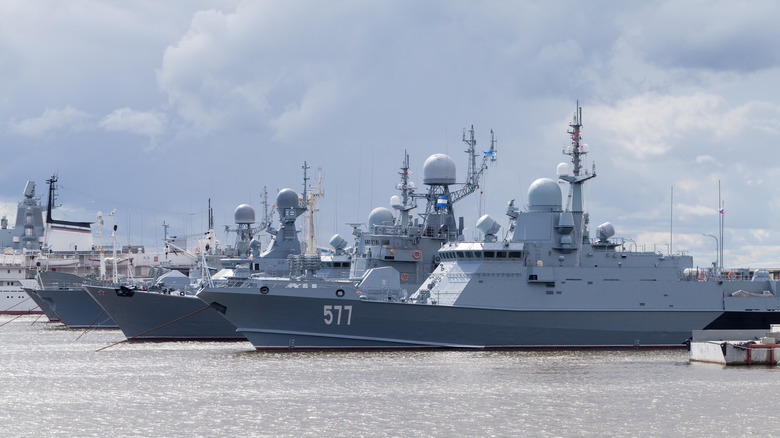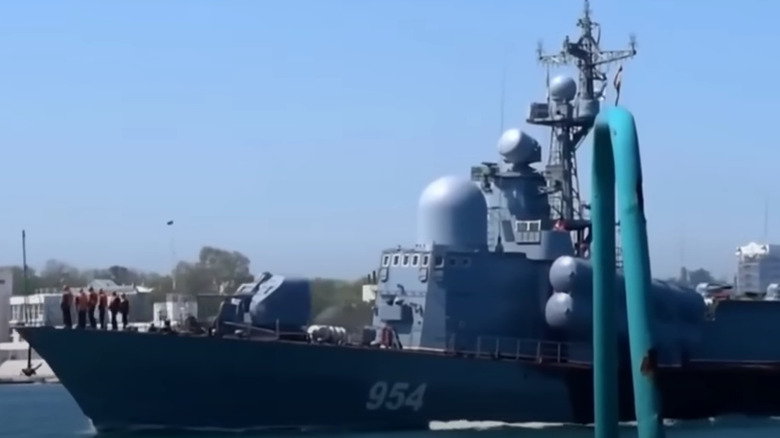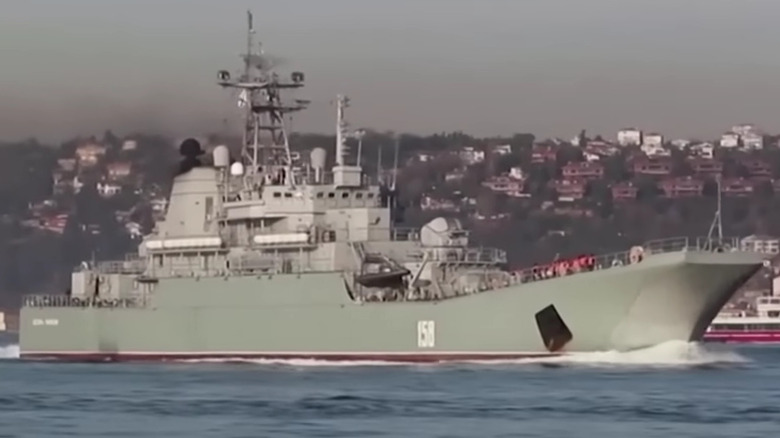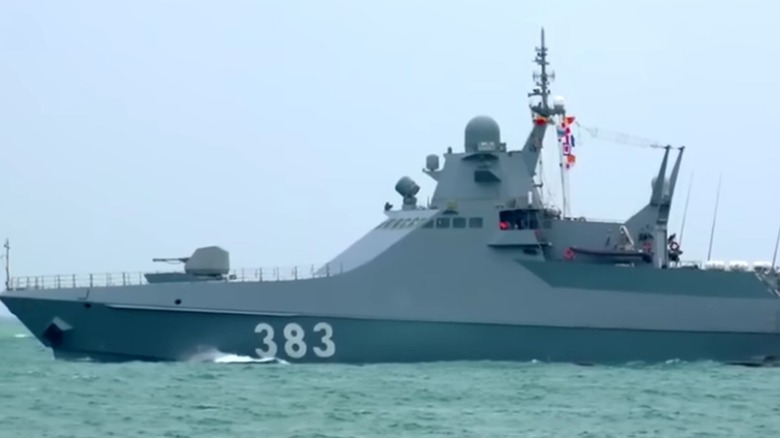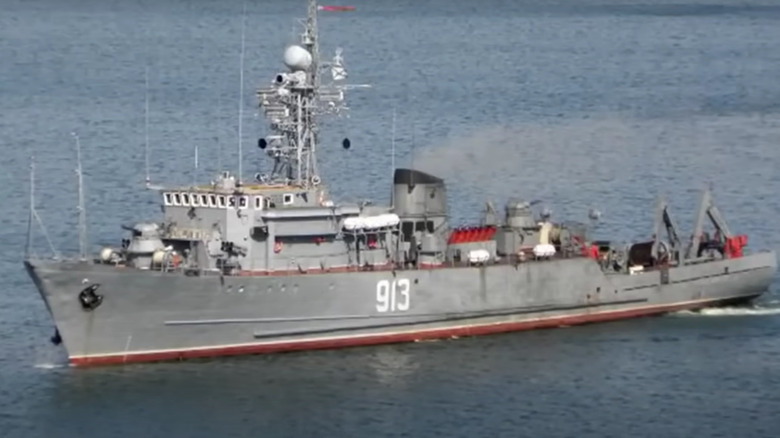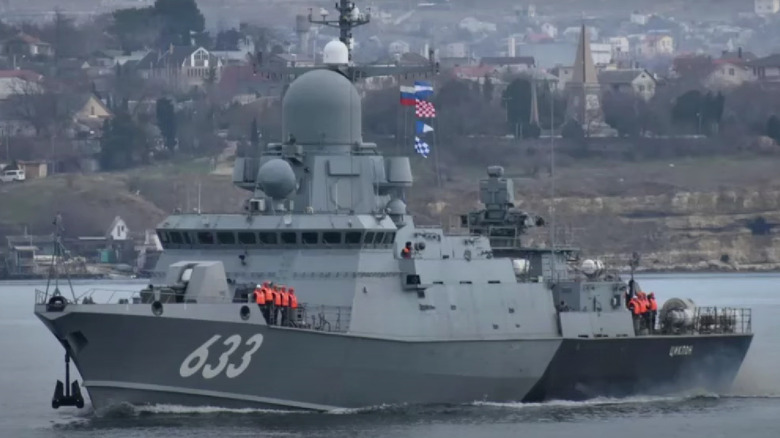Which Russian Warships Have Been Sunk In 2024 & Were Any Of Them Aircraft Carriers?
February 2022 is the date that Russia began its invasion attempt of Ukraine. For two years, the two nations have been at war, with Ukraine defending itself considerably well. Possibly the biggest surprise is Ukraine's ability to cripple Russia's Black Sea Fleet, as the small country doesn't have a navy of its own in the form of large warships. Ukraine instead has used unmanned maritime drones and long-range anti-ship missiles to assault Russian warships. Ukraine does have its own fighter jets, but its current maritime methods have not only been incredibly effective, they've also been considerably surprising.
Director of the Russia Maritime Studies Institute at the U.S. Naval War College in Rhode Island, Michael Petersen, said, "Ukraine's success in the Black Sea this year certainly came as a surprise to many of us. At sea, the Ukrainians have proven to be much more technologically and tactically innovative than the Russians have," according to RFE/RL. Ukraine needs access to the Black Sea shipping lanes in order to get grain through, as grain is vital to their economy. When the invasion started, Russia had roughly 80 guided-missile ships, landing ships, submarines, and patrol boats. By March 2024, it was reported that a third of Russia's Black Sea Fleet had been sunk or destroyed.
In 2024 alone, five Russian vessels have been destroyed. None of them were aircraft carriers because they only have one, the Admiral Kuznetsov, and it has been docked and under repair for some time.
Drones took down the Ivanovets
On the night of January 31, 2024, Ukraine sent out six of its satellite-controlled drones to swarm Russia's Tarantul-class missile corvette, the Ivanovets. The attack happened out on Lake Donuzlav, a saltwater bay that opens up to the Black Sea, where a Russian naval base is located. Ukraine released footage of the drone strike that shows the Ivanovets attempting to out-maneuver the drones to no avail. The jet ski-powered drones exploded on impact and left the Russian vessel crippled until it gradually sank beneath the water.
Ukraine has been concentrating its attacks near the Crimea peninsula because it makes it significantly more difficult for Russia to maintain its frontline operations on the mainland. Just before the operation against the Ivanovets, Ukraine sent 20 guided missiles off of the coast of Crimea. The Ivanovets was armed with anti-ship and anti-air missiles, designed to engage with all manner of vessels. It's upgraded radar system provided the ability for missiles to trace up to 15 targets simultaneously.
It was capable of traveling as fast as 41 knots, which wasn't fast enough to outrun the drones. The Ukrainian maritime drones, known as Magura V5 drones, are capable of a burst speed of 48 mph, or 42 knots.
The landing ship Caesar Kunikov
Just a few weeks after sinking the Ivanovets, Ukraine took aim of Russia's landing ship, the Caesar Kunikov. On February 14, just 10 days shy of the invasion's two-year anniversary, Ukraine sent out its Magura V5 drones and successfully sank the landing ship just off the coast of the Crimea peninsula near the city Alupka. Ukraine said it attempted to rescue 87 crew members, but the operation was unsuccessful.
The landing ship was commissioned by the Soviet Navy in 1986 and designed to carry up to 500 tons of cargo, including troops, that it can deploy onto land quickly. Since it's difficult to complete such an operation in Ukraine, Russia has been using its landing ships to transport supplies. While the Ropucha-class ship that the Caesar Kunikov was armed with defensive weaponry, such as two twin-barreled 57-millimeter AK-257 autocannons and a 76-millimeter turreted gun, they lack electronic weaponry systems that's especially beneficial against drones like the ones Ukraine uses.
The Magura V5 drones are simply too fast for landing ships like the Kunikov. It's only capable of traveling up to 18 knots, leaving it fairly vulnerable to something like a kamikaze drone hurling at it at 42 knots.
The Sergei Kotov patrol ship
Nobody can accuse Russia of shoddy craftsmanship with their ships. Ukraine might have sunk a small patrol ship, the Sergei Kotov, in March 2024, but that came after the very same vessel was attacked in July, August, and September 2023. It eventually succumbed to a drone strike conducted by Ukraine's special unit Group 13, sustaining damage on both starboard and port sides that resulted in the ship sinking. The Sergei Kotov was a newer 1,300-ton ship that Russia commissioned in July 2022 and, according to a representative from Ukraine's Ministry of Defense Andriy Yusov, intended to use as a platform for anti-aircraft missiles.
When the patrol ship was built, it came armed with an AK-176MA-01 naval gun and two heavy machine guns. Additionally, there's a landing pad for helicopters at the stern, primarily for rescue choppers. It could hold between 60 and 80 crew members. Ukraine's Defense Intelligence reported that seven Russian sailors died in the attack on the Sergei Kotov and another 27 were wounded, but there was no confirmation to this report.
The Kovrovets minesweeper
On May 19, Ukraine struck Russia's naval base in Sevastopol and sunk the Project 266M Akvamarin-class minesweeper ship, the Kovrovets. Unlike other Ukrainian assaults against Russia's Black Sea Fleet, the method of attack was not immediately disclosed. However, the next day, it was reported that the Kovrovets was hit by Ukrainian guided missiles. Those guided missiles would be the Army Tactical Missile Systems (ATACMS) that the U.S. donated, along with missiles that have between a 170 and 190-mile range. Ukraine has been using these missiles to cripple Russian air bases, air defense installations, training grounds, and naval bases like the one the minesweeper vessel was in when the attack took place.
The Kovrovets was commissioned in 1974 when the Soviet Union was still together. While it was designed to detect mines as deep as 500 feet, it wasn't without its defenses. The Kovrovets came armed with two 30-millimeter AK-230M naval guns. The USSR built its hull out of material that didn't have a high magnetic signature, allowing it to safely navigate through maritime minefields.
The Tsyklon missile corvette
A day after Ukraine sank Russia's mine-detecting ship, reports came in that confirmed Ukraine also sank an even more significant asset in the Black Sea. The guided-missile corvette, the Tsyklon, was destroyed by the same long-range ATACMS M48 and M57 missiles that sent the Kovrovets to the bottom of the harbor. The poor thing never even had a chance to fire a single cruise missile while on active duty. This was a huge accomplishment for Ukraine because the Tsyklon was one of Russia's newer ships, entering service only a year prior in July 2023.
The attacks against Russian naval vessels have been exceedingly successful, hindering Russia's ability to hold a superior force in the Black Sea. Phillips O'Brien, a professor of strategic studies at the University of St. Andrews in Scotland, talked to Forbes and said, "If ATACMS are taking out Russian warships in Sevastopol, hard to see the base having much utility left for the Russians." These missile strikes show that Russian vessels aren't safe out at sea, where Ukraine can and will use its Magura V5 drones, or in a port where they're sitting ducks for guided missiles armed with 470-pound warheads.
